Uncrewed surface vessel (USV) operations amongst NATO members are undergoing something of a sea change, due in large part to lessons learned from the maritime components of the ongoing Russo–Ukraine war. At the recent Portuguese Navy-led, NATO co-hosted ‘REPMUS 2024’ (Robotic Experimentation and Prototyping with Maritime Unmanned Systems) exercise held at Troia, southern Portugal, Allied navies and their supporting naval industrial base tested USV platforms in new concepts of operation (CONOPS) designed to harness and enhance what is an evolving contribution of maritime uncrewed systems (MUS) as a whole to NATO capabilities and operations.
NATO navies have introduced MUS capabilities into operations initially for two broad purposes: intelligence, surveillance, and reconnaissance (ISR) tasks; and mine counter-measures (MCM) activities. The primary aim of so doing was to exploit the absence of personnel onboard to conduct what are termed the ‘3-D’ missions (‘dull’, ‘dirty’, and ‘dangerous’), with the uncrewed system able to step into harm’s way in order to conduct, for example, anti-submarine warfare (ASW) sensing or mine identification and destruction. In these contexts, keeping the operator out of harm’s way was key. USVs were often seen as the platform that would be positioned up-threat, and would then deploy uncrewed underwater vehicles (UUVs) to tackle the ASW or MCM problem.
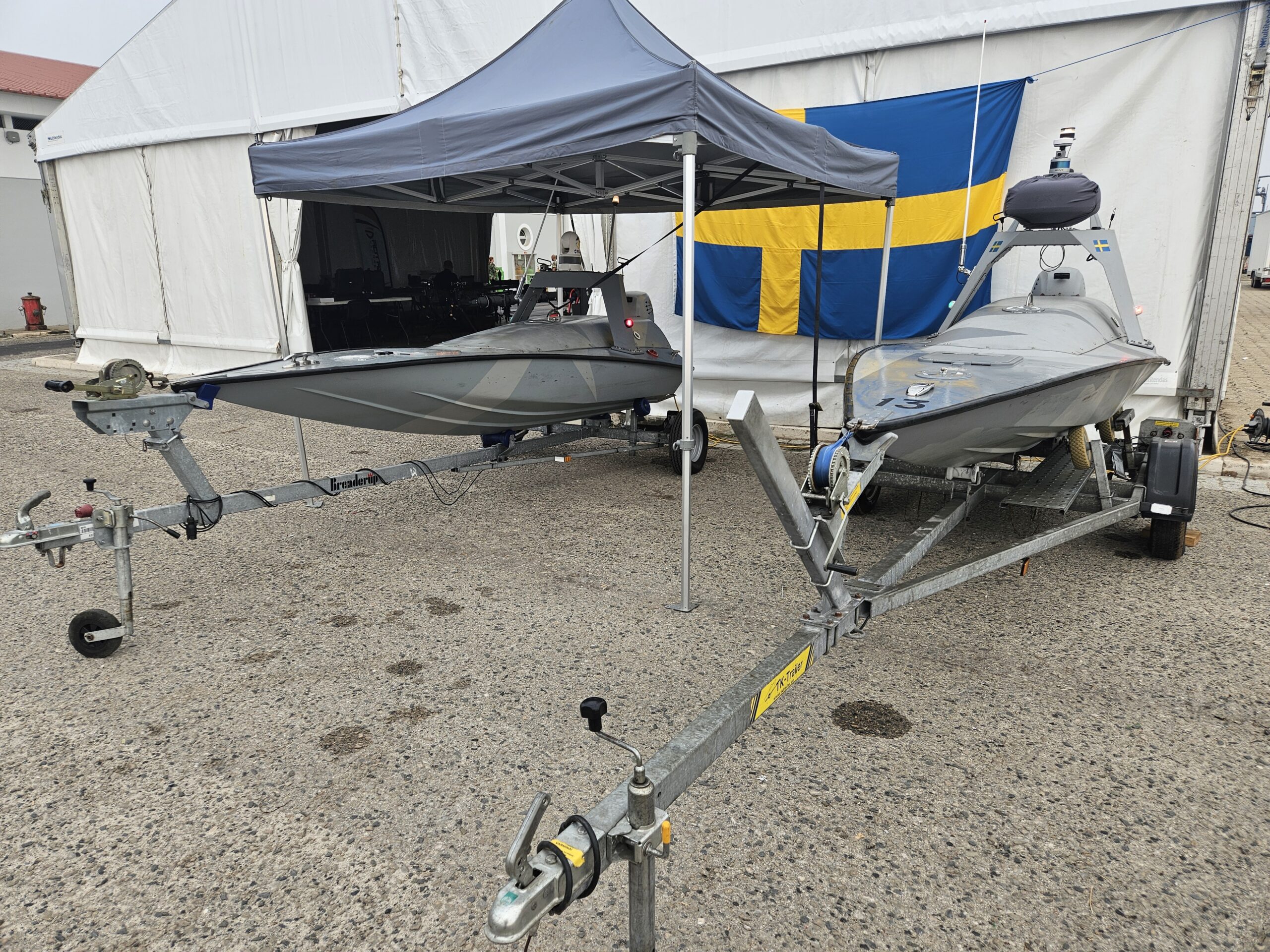
Credit: Dr Lee Willett
As Western navies have become more knowledgeable of and more comfortable with what MUS technology could offer and how it could be exploited, inevitably their ways and means for using USVs, for example, have begun to evolve.
However, the realities of high-end conventional combat in the ongoing Russo–Ukraine war appear to have accelerated this thought process, perhaps prompting more of a revolution in thinking about how to use MUS capability – even if evolutionary development may have drawn the same conclusions in due course.
The Russo–Ukraine conflict has demonstrated not only key capabilities but key lessons for Western navies in thinking about MUS use.
First, while these navies certainly see MUS as providing mass at sea to generate non-kinetic outputs – like sensing presence, in particular – combat in Ukraine has shown that systems both old and new will be fired in considerable numbers in contemporary conventional conflict, for both defensive and offensive purposes.
Second, for USVs in particular, the Ukrainian Navy has been able to use this relatively new capability – remotely operated through a ‘first person view’ (FPV) concept of employment (CONEMP) – and other stand-off systems including cruise missiles in offensive operations across the Black Sea to drive Russia’s Black Sea Fleet back to its own coastline. The ability to strike a ship at sea or a submarine in port with a missile, or to literally drive a USV straight into a ship at sea or in port, has enabled the Ukrainian Navy to establish an operational-level anti-access/area denial (A2/AD) ‘bubble’ – and thus achieve a significant degree of sea denial – effectively without having at sea a traditional naval force structure, command-and-control (C2) capability, or even people.

Credit: Peter Felstead
While some have argued that Ukraine’s experience in the Black Sea, including with its use of USVs, has demonstrated that traditional, large-scale naval force structures may no longer be needed, others have argued that Ukraine has demonstrated the use of a new kind of naval force structure.
Ukraine’s offensive operations conducted in the Black Sea have also underlined the importance of mass even with new capabilities including USVs, with the vessels designed to be expendable against targets and facing the risk of being attritable by Russian defences. While Western naval budgets may be beginning to grow over the longer term, they may not yet be growing fast enough or far enough to build the mass the navies may need in the shorter term; thus, USVs offer the chance to build mass and, as demonstrated in Ukraine, the opportunity to develop new and highly effective force-multiplying tactics.
Today, too, the wider availability of technology acts as another force multiplier when harnessed to new platforms such as USVs – for example, using FPV technology to turn the vessels into uncrewed kamikaze assets.
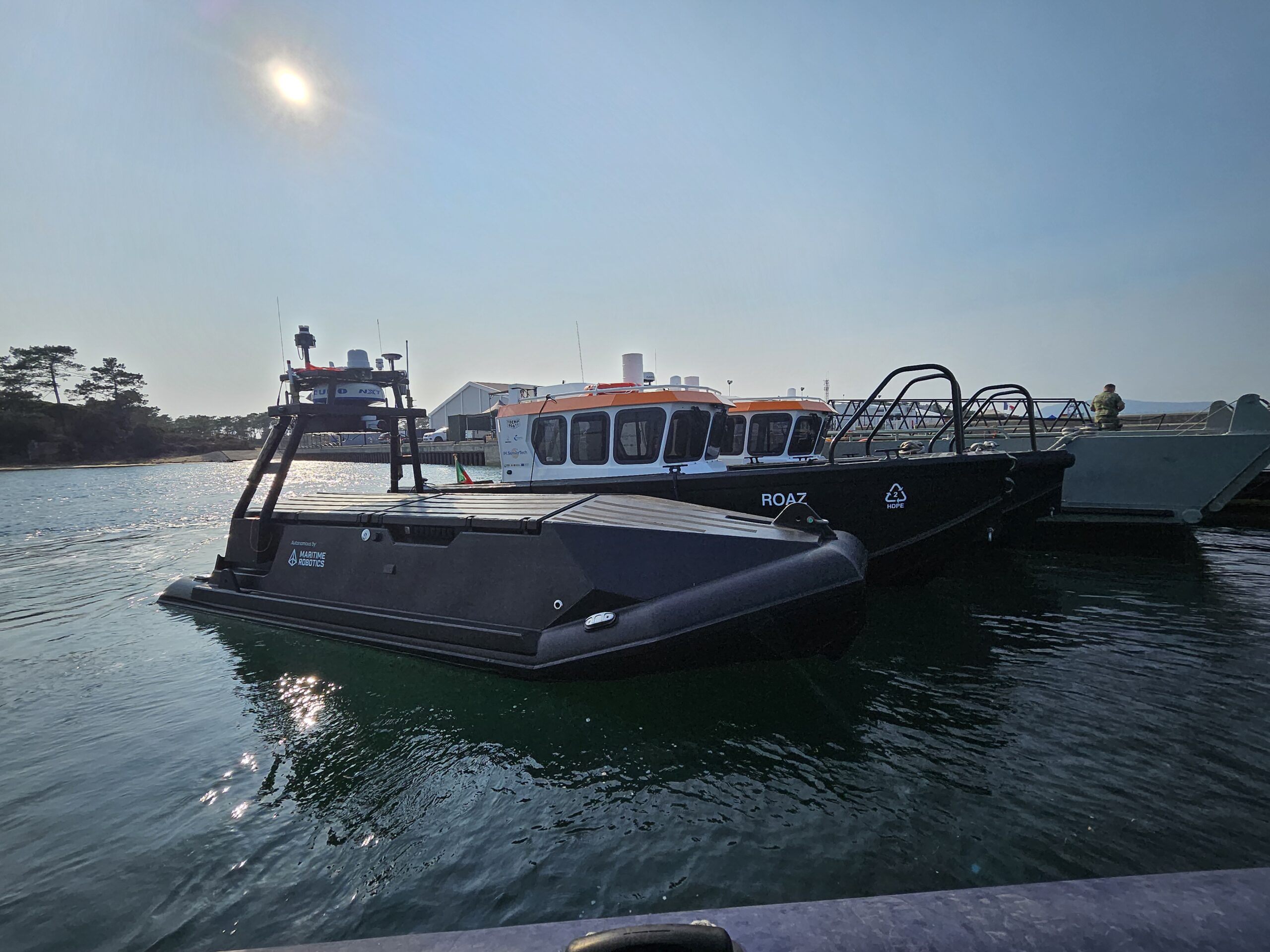
Credit: NATO
Lessons learned
The exercise serials constructed and conducted at ‘REPMUS 2024’ seemed to reflect a shift in operational emphasis amongst NATO navies, with greater focus on using USVs for kinetic purposes, including in integrated, multi-domain operations (MDOs). This indicated that NATO has learned some significant lessons from observing how Ukraine’s use of affordable but capable USVs can fundamentally shape and impact naval operations.
At the REPMUS exercise, which took place in September, around 20 USVs from different countries and different companies participated; a collection of surface ships were also present.
USVs were used in defensive operations, for example in harbour protection serials and to secure critical undersea infrastructure (CUI). They were also used to conduct offensive operations, including being integrated with other MUS like unmanned aerial vehicles (UAVs) to generate MDO-based outputs.
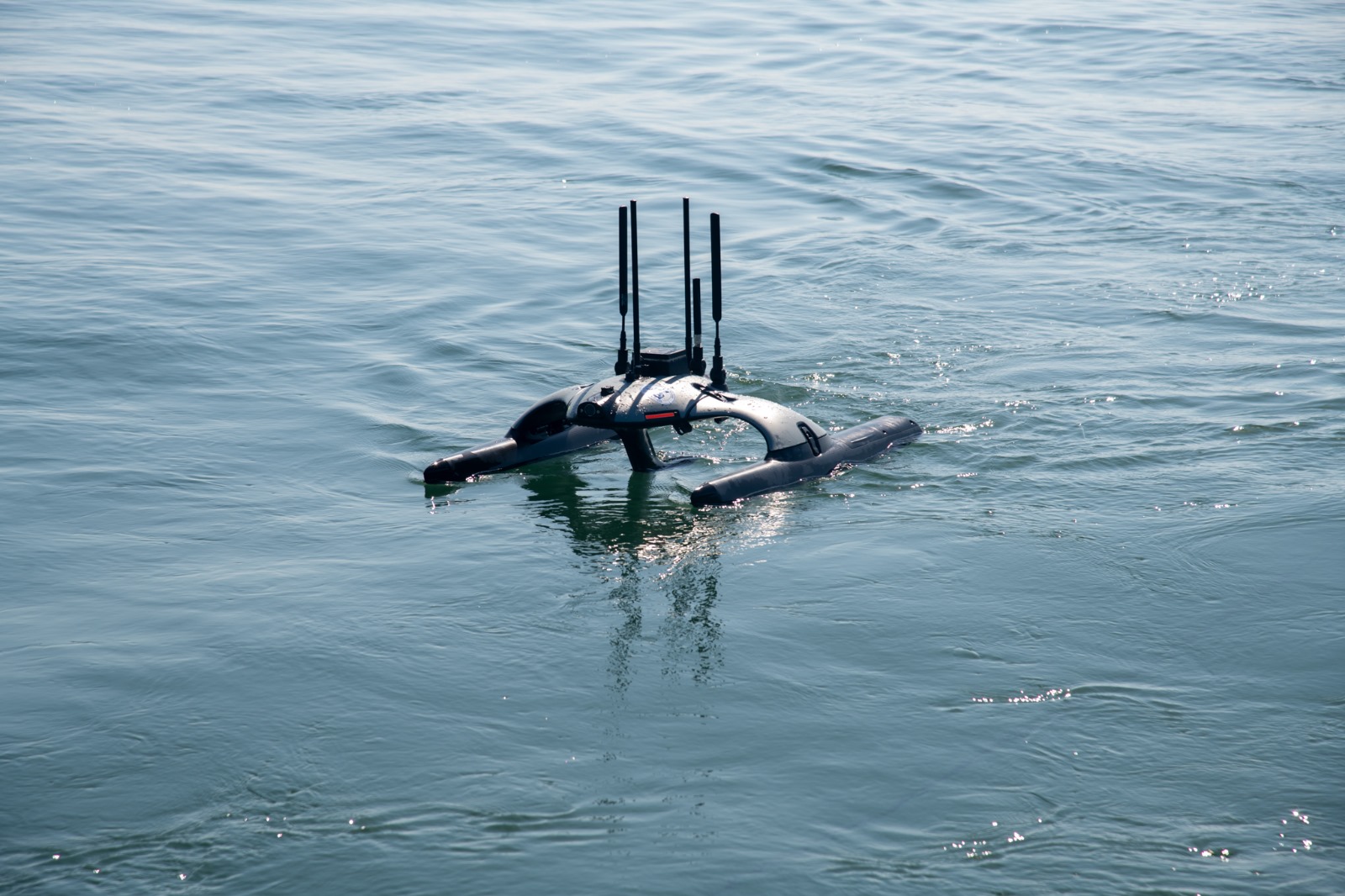
Credit: Portuguese Navy
At the Royal United Service’s Institute’s annual C4ISTAR conference, held in London on 3 October 2024, participants discussed how MDO-based operations were conceived in large part to offset A2/AD ‘bubbles’. Clearly here, USVs and UAVs working together can add different layers to the MDO capability, and thus to its efforts to lance such ‘bubbles’.
An operational experimentation exercise like REPMUS evolves and builds across its timeline to conclude with a tactical phase, where ‘free play’ is used to test capabilities and tactics with greater operational realism. For REPMUS 24, the tactical phase was designed to help further improve understanding of using USVs in live operations in both defensive and offensive modes.
“For the first time, we will play a LIVEX where we inject incidents but give freedom of manoeuvre to the ‘blue forces’ and ‘red forces’, with Exercise Control (EXCON) assuring safety,” Captain António Mourinha, a Portuguese Navy officer and chief of staff for the exercise, alongside his posting as Director of the Navy’s Centre for Naval Operational Experimentation (CEOM), told European Security & Defence, in an interview at CEOM’s base in Troia, during the exercise. The tactical phase focused on surface exercises (SURFEXs) for surface ships and USVs, but also included anti-air warfare serials. “Under this construct, we are testing defence against both USVs and UAVs,” said Capt Mourinha.
This SURFEX was designed to achieve two aims, Capt Mourinha continued: first, to defend ‘blue forces’ against USV and UAV threats; and second, to evolve ‘red force’ tactics to use USVs in attack missions. “So, in a single exercise, we double the results because we test USVs in attacking ships and we test the defences the ships can have against USVs,” Capt Mourinha explained.
“One of the focus areas for REPMUS this year is counter-UxVs, in all domains,” Capt Mourinha added. “We are trying to protect the [CEOM] site from all types of drones, with many ‘red forces’ and many surveillance capabilities. We are also using uncrewed systems against uncrewed systems.”
The Ukrainian Navy was expected to participate in the SURFEX serials, including by supporting the ‘red force’ team. Ukraine’s USV presence would have enabled NATO navies to draw on Ukraine’s real-world operational experience of using such capabilities in the Black Sea, enhancing the realism in training benefit.

Credit: NATO
The serials enabled the assembled navies to work through methodologies, including C2, for conducting both offensive and defensive operations using USVs. The numbers of USVs present at the exercise also enabled a degree of mass to be implemented in the serials, with USVs on the ‘red force’ (for example) able to use different axes of attack to confuse ‘blue force’ defences. In addition, larger and smaller USVs were mixed together in the serials, to provide respectively both overt and covert lines of attack, with such attacks often conducted in a co-ordinated manner to further confuse defences.
In defensive contexts, REPMUS also tested the use of USVs in defending high-value assets (HVAs). Protecting HVAs like carrier strike groups (CSGs) or amphibious ready groups (ARGs) is a core operational priority for NATO navies. The US Navy has already talked about the future role large USVs could play in operating within such task groups, positioned out forward to conduct surveillance sweeps or to attack targets posing an anti-ship missile threat to the groups.
For both offensive and defensive operations, the relatively congested waters in the REPMUS exercise area – with, for example, different types and sizes of commercial vessels widely present – created the opportunity to test USV C2 and tactics in a cluttered environment, including for mission planning and collision avoidance.
USV capability
Amongst the 20 or so USVs present were four Piraya (Piranha) vessels from Swedish company Saab Kockums comprising two 4-m and two 1.5-m craft.
Underlining the focus on MDO, for some serials the Piraya USVs worked in partnership with UMS Skeldar V-200 UAVs. Participating in REPMUS for the first time, the Skeldar UAVs were fitted with a WESCAM MX night/day electro-optical/infra-red (EO/IR) camera payload. Experiments were conducted with this capability package to relay video data from the UAV, via its RadioNOR antenna system, to the Pirayas, so the USVs could see and use live video footage, Michel Egerborn, UMS Skeldar’s Demonstrations Manager, told ESD/MDM during an interview at REPMUS: this C2 capability was used to support ISR operations, augment the USV’s overall battlespace picture, and help identify potentially hostile targets.
Egerborn pointed to benefits offered by the combined capability. First, he said, at an operational level, “It’s an addition to have a common picture and to take decisions based on data.” Second, he added, at a tactical level “Skeldar can lead the USV to a target in a silent way.”
The presence of Swedish and Ukrainian USVs at REPMUS will have helped those two navies practice tactics, techniques, and procedures (TTPs) in a NATO context. In turn for NATO, the Swedish and Ukrainian participation will have provided NATO navies with the opportunity to draw on their operational experience in the Baltic and Black Seas, respectively – two key areas of strategic interest for the Alliance.
One USV capability revealed for the first time at the exercise – a system that demonstrates the enduring NATO focus on surveillance requirements, but also the evolving capacity to tackle other tasks – was the Portuguese Navy’s new Trator do Mar (or Sea Tractor) USV.
For a primary sensor, this USV is fitted with a towed array sonar system, and its basic CONOP is to conduct grid search patterns (like a tractor ploughing a field). However, it can also carry other capabilities, Commander Marco Guimarães, director of CEOV (Célula de Experimentação Operacional de Veículos Não Tripulados; the Navy’s MUS technology innovation and development cell) told ESD/MDM at REPMUS.
“This is a low-profile, discreet USV that was designed, built, and tested by the Portuguese Navy …. It is our design, our drawings, our specifications, and built by ourselves in our shops,” said Cdr Guimarães.
Powered by a hybrid propulsion system, the stealthy USV has long endurance – able to stay at sea for more than 30 days – and a long-range communications suite.
As regards its mission capabilities, Cdr Guimarães said “It’s a new USV with a mission that is multi-purpose. We plan to fit a towed-array sonar, to screen and to protect CUI.” The keel is fitted with nine attachment points, to which various different sensors can be fitted. “We can use all the sensors that are used by our hydrographic institute …. These sensors support scientific research and military operations,” Cdr Guimarães added.
The USV can be operated autonomously or remotely. At REPMUS it was run remotely, to enable the navy to connect and test more sensors with it.
With adaptable spaces onboard, the USV can be reconfigured to meet mission requirements, and thus can be equipped to contribute to operations in all domains. On operations, Cdr Guimarães explained, a single USV can be deployed or more than one can be sent together.
The USV was present at REPMUS to conduct testing of the vessel, its systems, its capabilities (including the sonar and communications suites), and its interoperability, as a final part of the process for demonstrating its readiness for operations. The exercise trials process for the USV included “Just tuning and small tests …. We are running checks: ticks in the boxes; this is done; this is done; this is done”, said Cdr Guimarães.
The USV tested at REPMUS was the first in an initial batch of four vessels: the others are in build. The navy is proceeding with the programme, Cdr Guimarães confirmed.
“We are ready,” Cdr Guimarães added. “This is just one piece of the puzzle.”
A core part of the CONOPS for the USV is to be able to deploy it on board the navy’s planned new ship, dedicated to MUS operations. Named Dom João Segundo, this new ship is known in the Portuguese Navy as the ‘drone carrier’.
“The USV was built in order to be one of the pieces that will embark on the ‘drone carrier’,” said Cdr Guimarães. “This will be an organic USV for that ship.” With all cranes and lift systems on board intended to be able to launch and recover the USV, it can be deployed over the side or over the stern.
“We also can use the USVs in our coastal patrol vessels,” Cdr Guimarães added.
In terms of the CONOPS for the ‘drone carrier’, “The platform is threat agnostic, but you choose the effectors you want onboard,” Admiral Henrique Gouveia e Melo, Portugal’s Chief of Navy, told ESD/MDM. “What’s the threat? It’s an aerial threat? OK, we can move to that ship a big air wing with a lot of UAVs, and will be effective combating the threat in that environment. What is the threat? It’s surface. OK, we will move a lot of USVs and the ship will be surface warfare-capable. Or the threat is multi-scenario: we will deploy UAVs, USVs, UUVs.”
“That platform gives us the flexibility and the agility to adapt to threats into the future. That’s our vision,” Adm Melo added.
To deliver integrated capability, the ‘drone carrier’ also will deliver interoperability. This process was tested too at REPMUS. A core part of the exercise in its 2023 and 2024 iterations has been the establishment of several shore-based ‘virtual ships’ to represent and operate – in simulated terms – sea-based commander task units (CTUs).
The CTUs – of which there were four naval operational nodes at the exercise, CTUs Lisbon, London, Madrid, and Washington – provide C2 nodes through which exercise serials are conducted. They also provide a construct around which OPEX takes place – including how to integrate MUS into operations with both crewed and uncrewed assets.
Cdr Guimarães commanded CTU Lisbon during REPMUS. “From the CTU Lisbon side, one of our goals was experimenting with co-ordination, because we are building the ‘drone carrier’. For us, CTU Lisbon is that ship,” he explained. “We are experimenting now with how we can integrate uncrewed systems onboard that ship and how can we play with those assets in that ship.”
In this context, at REPMUS the navy experimented with building MUS interconnectivity; the capacity to operate MUS deployed from the same ship simultaneously in the air, surface, and sub-surface environments; and industry integration within the development of this approach. Testing MUS connectivity through CTU Lisbon at ‘REPMUS’ in order to develop integration capacity for MUS systems and the ‘drone carrier’ helps the navy understand which systems can be deployed from the carrier, as well as which systems may also be suitable for the coastal patrol vessels.
The Portuguese Navy is also working with other navies on USV concepts and programmes that could be developed together to provide interchangeable capabilities for each other’s ships.
“Until now, we were working on the pieces of a puzzle: now, we are putting the puzzle together,” concluded Cdr Guimarães.
Dr Lee Willett



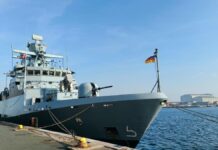
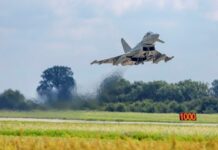
![Hybrid navies: Integrating uncrewed capability into carrier strike The US Navy (USN) carrier USS John C Stennis (left), the French Navy carrier FS Charles de Gaulle, and elements of their strike groups are pictured sailing together in US Fifth Fleet’s area of operations. The US, French, and UK navies are all developing ‘hybrid’ crewed/uncrewed mixes for their carrier airwing capability. [US Navy]](https://euro-sd.com/wp-content/uploads/2025/09/2-HST-CdG-USN-Kopie-218x150.jpg)
![Strategic shift: UK CSG deployment demonstrates switch in UK strategic focus The UK aircraft carrier HMS Prince of Wales (foreground) sails alongside the US carrier USS George Washington during Australia’s ‘Talisman Sabre’ exercise in July 2025. The two carrier strike groups (CSGs), plus Australian Navy assets, conducted CSG integration activities. [Crown copyright 2025]](https://euro-sd.com/wp-content/uploads/2025/09/1-PWLS-GW-TSabre-CC-UK-MoD-25-Kopie-218x150.jpg)

![MGCS status update The KNDS EMBT-ADT 140 technology demonstrator on display at the Eurosatory 2024 exhibition. This model featured the 140 mm configuration of the ASCALON gun. [Mark Cazalet]](https://euro-sd.com/wp-content/uploads/2025/08/EMBT-EDT-140_Mark-Cazalet-Kopie-218x150.jpg)
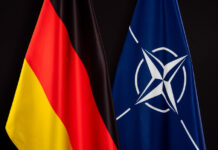
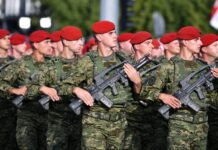
![Ripples in the air, rupture in the ether Pictured: 1L269 Krasukha-2 jamming system. Since 2008, Russia has greatly expanded its EW capabilities, and since 2022 it has gained valuable direct experience contesting the EMS in Ukraine, where continuous innovation occurs over very short timescales. [RecoMonkey]](https://euro-sd.com/wp-content/uploads/2025/07/1L269-Krasukha-2_RecoMonkey-Kopie-218x150.jpg)